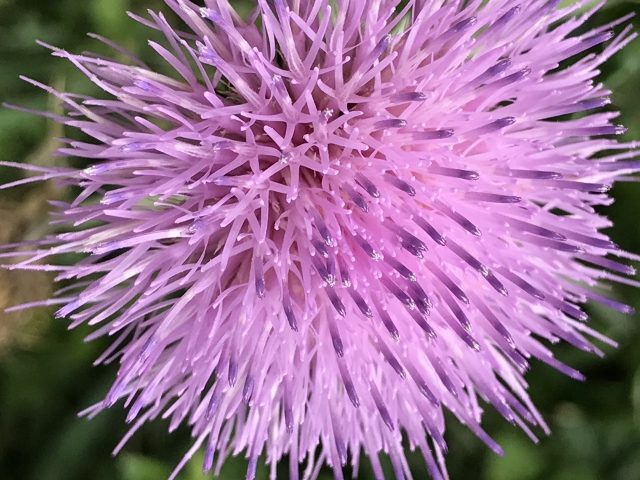After the Big Freeze, we still really don’t know what to expect. I’m thrilled every time I see a bug — I’ve seen so few yet this year.
The cat sitting in the window the other day called my attention to a really big bug on the outside of the screen. I raced out to capture a photo of it before it leapt away. I identified it through iNaturalist as Acanthocephala alata, a bug in the lead-footed family of Coreidae. They are not considered a beneficial bug in the garden as they eat plants and ripe fruit, like tomatoes and citrus.

A rough stink bug, Brochymena arborea, road along on the handlebars of the lawn mower for a spell. Stink bugs are considered beneficial bugs. They prey on plant-eating larvae of aphids and other soft-bodied insects. Sadly, they also eat caterpillars, beetles and larvae of beetles. Both leaf-footed bugs and stink bugs provide food for birds, spiders and other bugs.
That’s about it for bug sightings. In the plant world, things are greening up, but while the plants are starting from scratch, there is a decided shortage of blooms. Native plants in different areas of the Valley seem to be showing signs of life at different times. While many of us wait to see what comes back, we’re allowing free rein to any plant showing blooms.
Any other year, I would be trying to keep ahead of the yellow-blooming sow thistles because they produce millions of seeds; instead, I’m letting them stay around for the pollinators. For more about our two sow thistles, see the second part of an earlier blog post at the sub-title, “The Stow-aways,” at this link: https://rgvctmn.org/blog/anitas-blog-thistle-while-you-work/
The first portion of the above link is about Texas thistle, Cirsium texanum, one of my favorite March plants. The giant rosettes began showing up shortly after temperatures rose above freezing. In a normal year, I only let one or two mature on our property; again, the million seeds could make a veritable forest in a couple of years if allowed to grow unchecked. This year, because they are early bloomers, I’m letting a number of them mature.
Why I let Texas thistle mature is, one, it’s greatly photogenic. It’s really beautiful when you get a close up of the bloom.

Two, it’s always busy. I can count on it attracting a variety of insects. As a matter of fact, it was the leaf-footed bug I was looking for the other day when the thistle bloom finally burst out in all its pom-pom glory. I didn’t find any bugs, but amazingly, it was already drawing in butterflies. While I photographed, the flower was visited by a longtail, whirlabout and a pipevine swallowtail.


If you discover these huge rosettes in your lawn, let them grow and mature. It will be helpful during the up-coming City Nature Challenge by supplying a number of bugs and butterflies to photograph and upload.
If you’re from the Midwest, don’t cringe — this is a native Texas thistle, Cirsium texanum — not the invasive Canada thistle, Cirsium arvense.
Thistles are important to a habitat for nectar and pollen for bees, butterflies and other pollinators. Many insects feed on the leaves, stems, flowers and seeds. They are host plants for painted lady butterflies and leaf-footed bugs. Birds eat the seeds. The seed fluff may be used in nest building by some birds.
Again, check out the above link for more attributes of the awesome Texas thistle.
The next day, a lot of whirlabouts were whirling about the thistle. Three landed on a bloom. The opposite side of that bloom revealed a phenomenon of nature: a fasciated bloom


Plant fasciation is thought to be a random genetic mutation or disruption that results in flowers that are flattened and elongated or otherwise misshapen (meaning ugly); two blooms seemingly fused together, or an abnormal number of flowers on one stem. Fasciation also may be caused by a bacterium, viral infection or damage to the plants by frost, animals (including insects), or chemical or mechanical injury. I’d not witnessed a fasciated thistle before and the butterflies certainly weren’t bothered by it.
Although Texas has about 10 native thistles, it also has a number of thistles listed as invasive, they include:
Invasive thistle in Texas:
- Nodding or musk thistle, Carduus nutans
- Scotch thistle, Onopordum acanthium
- Bull thistle, Cirsium vulgare
- Plumeless thistle, Carduus acanthoides
- Canada thistle, Cirsium arvense
- Milk thistle, Silybum marianum
- Distaff thistle, Carthamus lanatus
An excellent blog post by K. Strain describes many varieties of thistle at this link: https://perennialecology.wordpress.com/2017/08/13/the-good-the-bad-the-ugly-a-guide-to-distinguishing-texas-thistles/
Thistle leaves have wicked prickles. The plant begins with a rosette on the ground. Another interesting native plant that can be mistaken for thistle — until it blooms — is commonly called prickly poppy. It, too, first appears as a flat rosette on the ground. Prickly poppies are keepers, too. They attract beetles and other pollinators; they can usually be counted on to hold a bug or two inside the bowl of the bloom. Prickly poppy leaves are wicked like thistle leaves; they have a couple of distinguishing features: the leaf rachis is bright white, and the leaves have a blue-green cast to them. Thistle leaves are over all green.





Leave a Reply